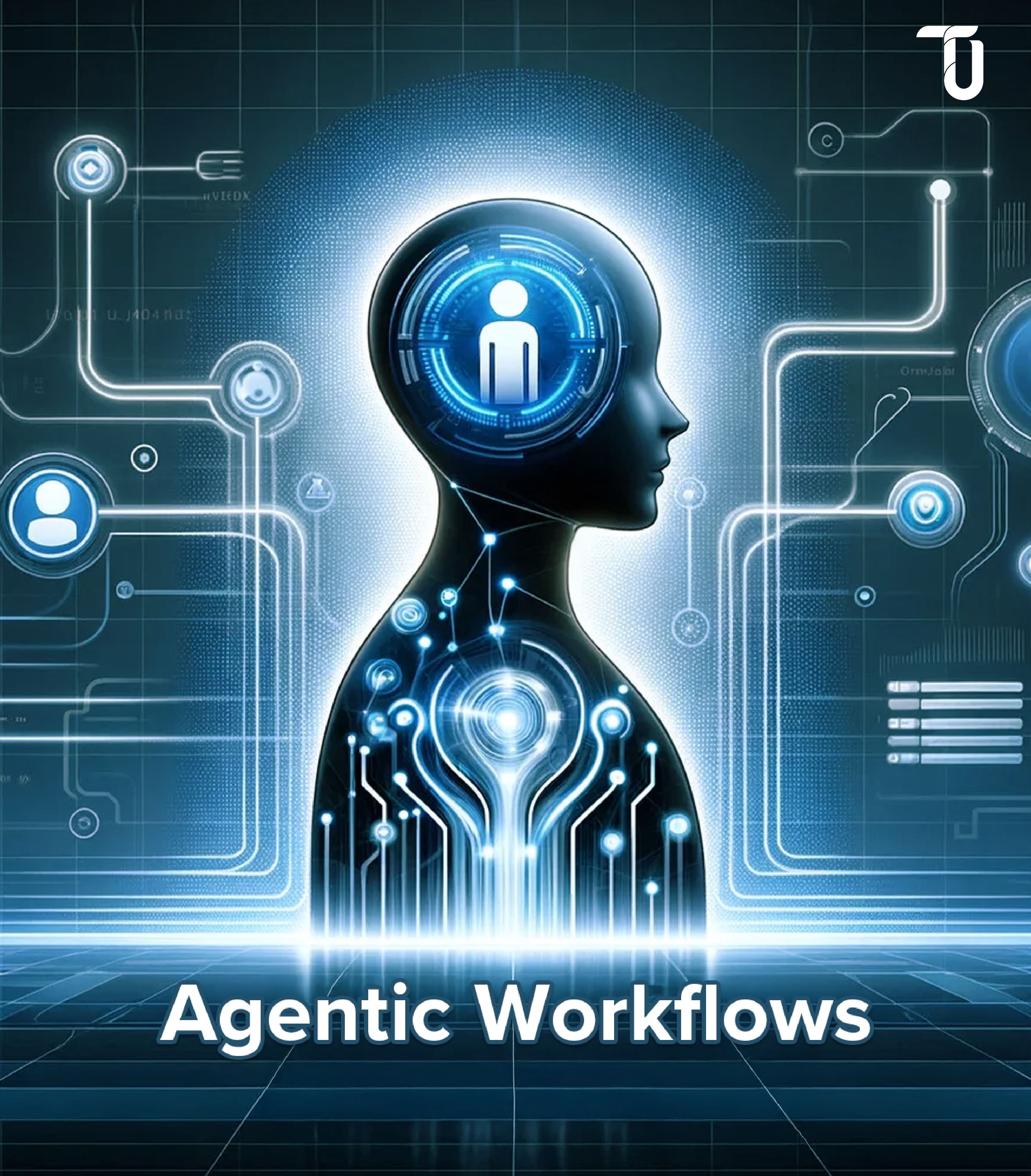What Are AI Agentic Workflows and How Do They Differ from Traditional AI Workflows?
AI agentic workflows are the pre-defined series of structured operations or actions that a single AI agent or multiple AI agents together manage and complete. AI agents are intelligent software systems that autonomously perform tasks, make decisions, and interact with the environment and users to achieve pre-defined goals. So, if you want your agentic AI system to complete tasks autonomously- be it a single-agent system or a multi-agent system- you must equip it with the agentic workflow.
Understanding AI Agent Workflow With a Customer Support Example
Suppose, a company leverages a Multi-agent System (MAS) to handle complex customer support interactions. The Agentic workflow defines how each AI agent must act autonomously. For this example, below is how each agent tentatively acts following a well-defined agentic workflow.
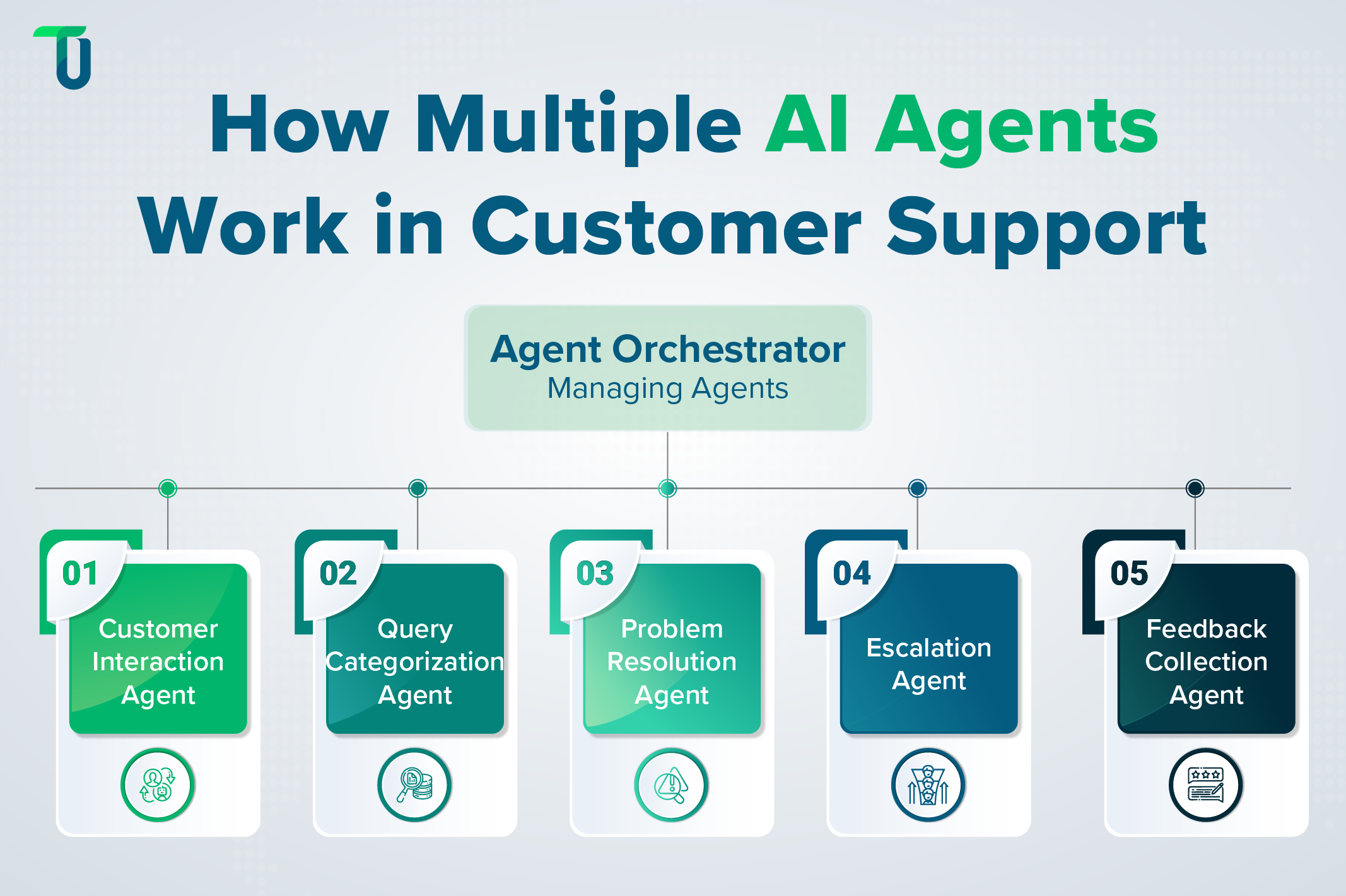
Agent Orchestrator: This AI agent initiates the other agents and ensures they complete their assigned tasks. It handles coordination among agents to complete the overall goal of the workflow; in our example- providing satisfactory responses to customers.
Agent 1 for Customer Interaction: Agent 1 must respond immediately to customer requests, like “How can I reset my password?” It reads the customer’s request, analyzes keywords, retrieves information from a knowledge base, and provides an appropriate response or solution, like a link to password reset instructions.
Agent 2 for Query Categorization: If the query is complex or outside Agent 1’s scope, the orchestrator agent initiates Agent 2, which analyzes the language of the query, identifies its intent (product issue, billing question, etc.), and categorizes the query.
Agent 3 for Problem Resolution: After query categorization, Agent 3 gets initiated and searches for a solution by interacting with the environment (systems and databases), as this agent must find a solution without human intervention.
Agent 4 for Escalation: If Agent 3 can’t find a solution, Agent 4 gets triggered and identifies the need to escalate. It collects additional information, like customer account details, issue severity, etc., and hands it over to the human agent to facilitate smooth customer interaction.
Agent 5 for Feedback Collection: After the problem is resolved (either by AI or a human agent), Agent 5 is initiated to analyze the tone of the customer’s response or survey feedback and assess whether the issue was resolved satisfactorily. This customer sentiment information is then used to train AI to improve interactions and workflow.
This example showcases how a multi-agent system handles complex tasks when it is given a well-defined AI agent workflow. It’s worth noting that not all systems may have an army of agents along with an agent orchestrator; it depends on the complexity of the workflow and the agentic architecture (single agent or multi agent) used to build the AI-based system.
How Agentic Workflows Outperform Traditional AI Workflows
Below are some of the qualities of AI agent workflows that are not found in traditional AI workflows:
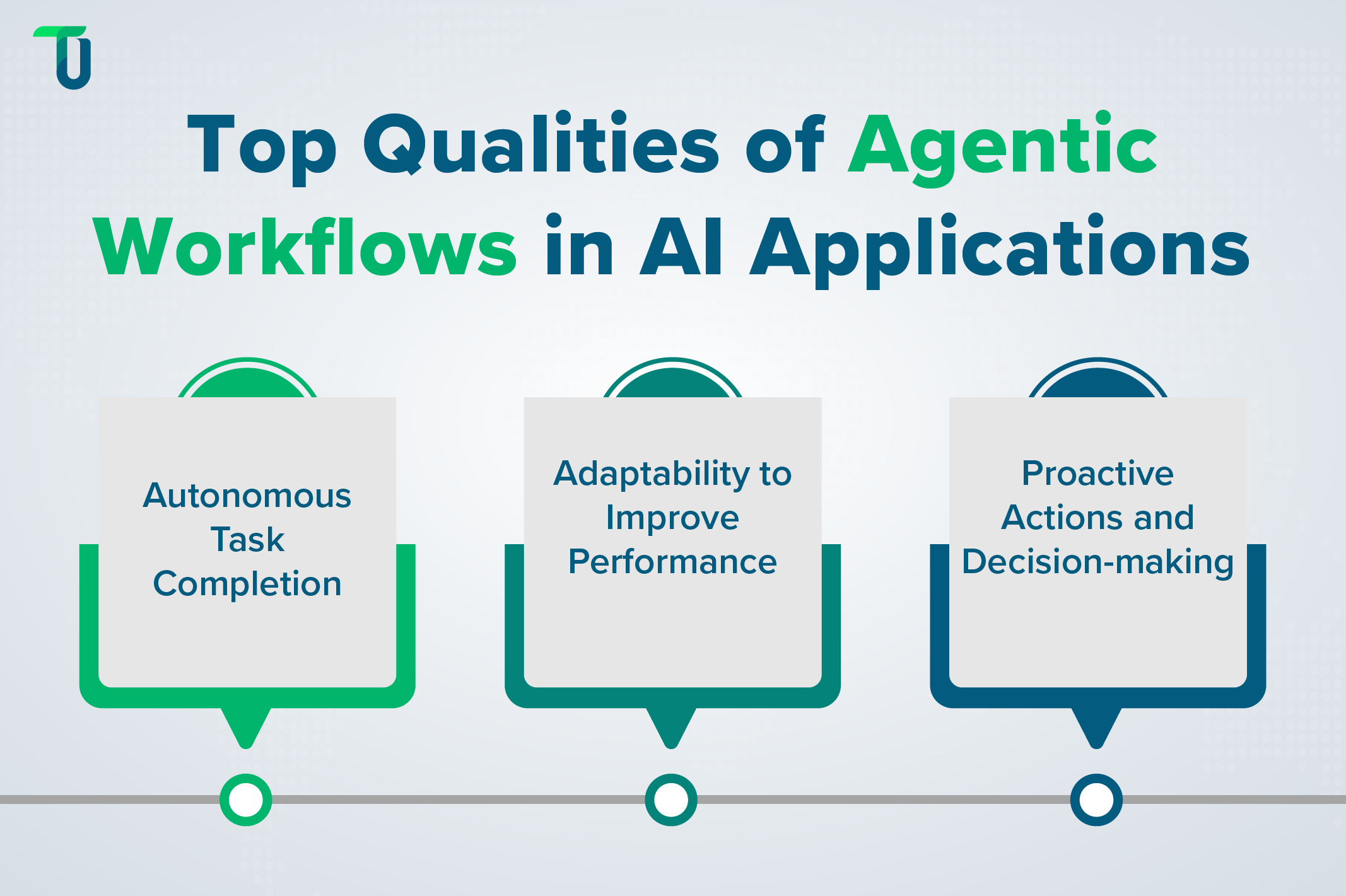
Autonomous Task Completion: Traditional AI workflows require external inputs at every step to complete a task. Even with task automation, human assistance and efforts to complete the workflow remain high. Whereas agentic workflows are trigger-based. So, AI agents get triggered to take actions autonomously when an event occurs. For example, the AI agent tasked with escalation gets triggered after the agent responsible for problem resolution fails, as we saw in the customer support system example above.
Adaptability to Improve Performance: Agentic workflows can be improved over time by allowing AI agents to learn from interactions and modifying their behavior accordingly, making them ideal for Automating continuous AI model training in dynamic enterprise environments. Techniques like reinforcement learning are utilized to enhance agentic AI performance. On the other hand, traditional AI workflows lack adaptability as they are based on fixed rules and linear processes.
Proactive Actions and Decision-making: Agentic workflows allow AI agents to proactively anticipate and address needs without getting external prompts. As they interact with the environment in real time, they make decisions based on the current scenarios while applying their previous learnings. This brings flexibility and agility to business operations.
With these outstanding features or qualities of agentic workflows over traditional AI workflows, they have already caught the attention of enterprises. In fact, a survey by Statista on AI agent integration in business suggests that companies are already prioritizing modernization and upgrades using AI agents in 2025, and 48% of 4021 respondent organizations aim to implement these changes within the next 3 years.
Ready to Utilize AI Agentic Workflows?
Agentic workflows are making processes smarter, faster, and autonomous for enterprises. Talk to our AI automation experts today!
Key Benefits of Agentic Workflows for Enterprises
We’ve already established how agentic workflows help automate complex, multi-step tasks that require abilities for decision-making and proactive action in real time. These capabilities of agentic AI enhance the business benefits for enterprises. They include:
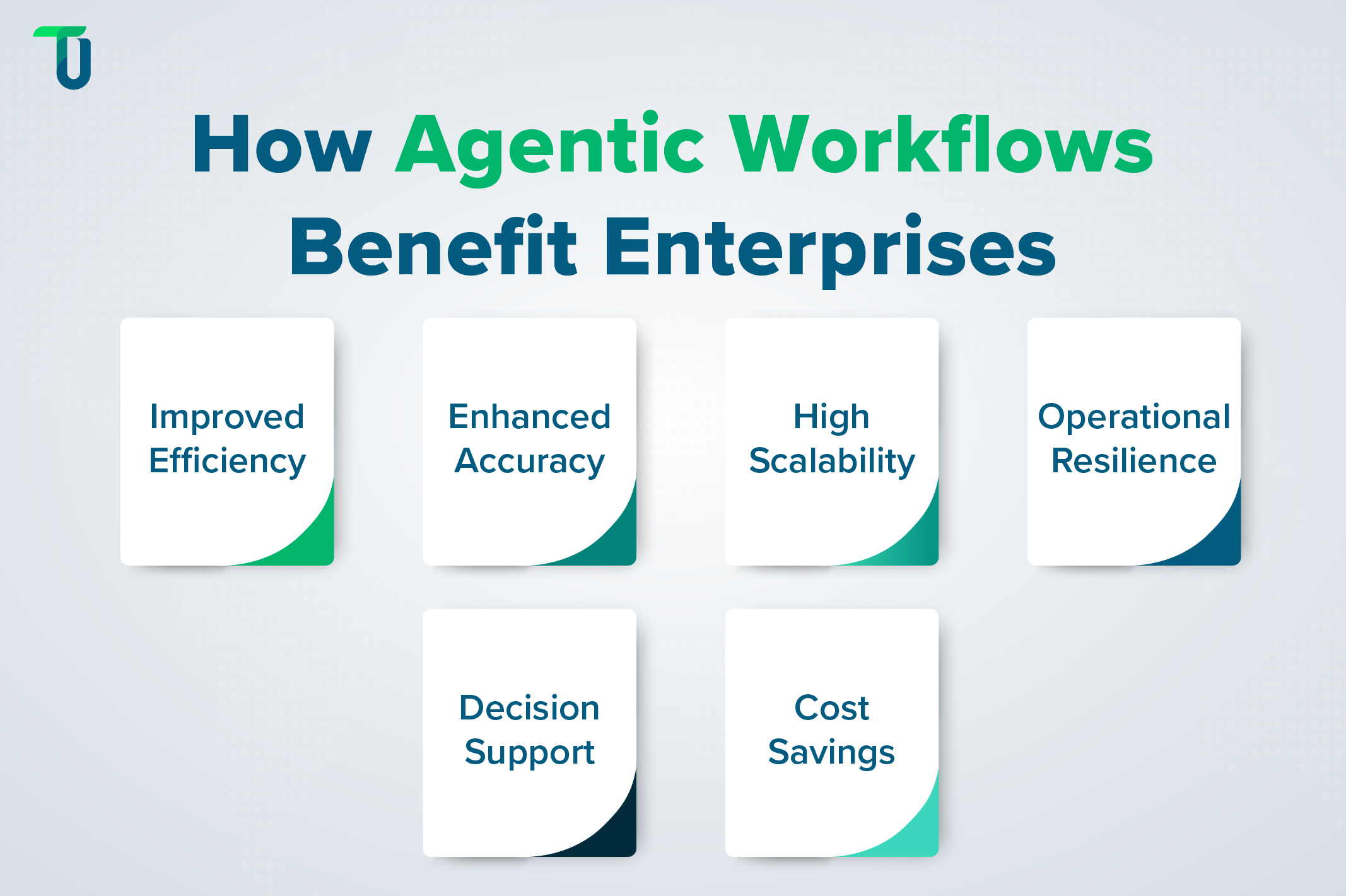
Improved Efficiency: Traditionally, automation catered to simple tasks and left enterprises with semi-automated processes. So, employees did the heavy lifting of navigating multiple automated systems while ensuring process completion manually. Agentic workflows allow AI agents to integrate with the environment to automate end-to-end processes. While human oversight remains essential, employees’ workloads decrease to critical reviews and approvals so they can focus on strategic activities, thus improving efficiency.
Enhanced Accuracy: Automation via agentic workflows eliminates delays usually caused due to communication gaps between teams and human errors resulting from the repetitive and mundane nature of assigned tasks. Agentic systems consistently carry out pre-defined tasks and flag discrepancies in the process to resolve them with either AI automation or human intervention. So, along with speed, the accuracy of output also increases.
High Scalability: Agentic workflows employing multiple agents are inherently scalable as they intelligently distribute tasks and optimize resource utilization. Agentic systems can effortlessly manage increased workloads by utilizing more computing power, but unlike traditional systems, they do not require infrastructure expansion.
Operational Resilience: As agentic workflows aim to equip AI agents with human-like thinking patterns and flexible actions to achieve pre-defined goals, business operations become resilient. The agentic system ensures it completes the task autonomously or with human intervention, without experiencing fatigue or missing out on key coordination.
Decision Support: Agentic workflows help management and employees make better decisions by providing data-backed insights and recommendations. So, they can make everyday operations efficient and faster as well as design smarter strategies for business growth.
Cost Savings: AI agentic workflows facilitate better resource management as your human resources focus more on strategic tasks and complete routine tasks using AI automation. So, work gets faster and more accurate, thus increasing efficiency and productivity. Over time, businesses save costs by using resources wisely and reducing expenses caused by delays and mistakes.
Popular Use Cases of AI Agentic Workflows for Enterprises
The smarter capabilities of AI agents can be applied in multiple departments and business verticals to automate processes.
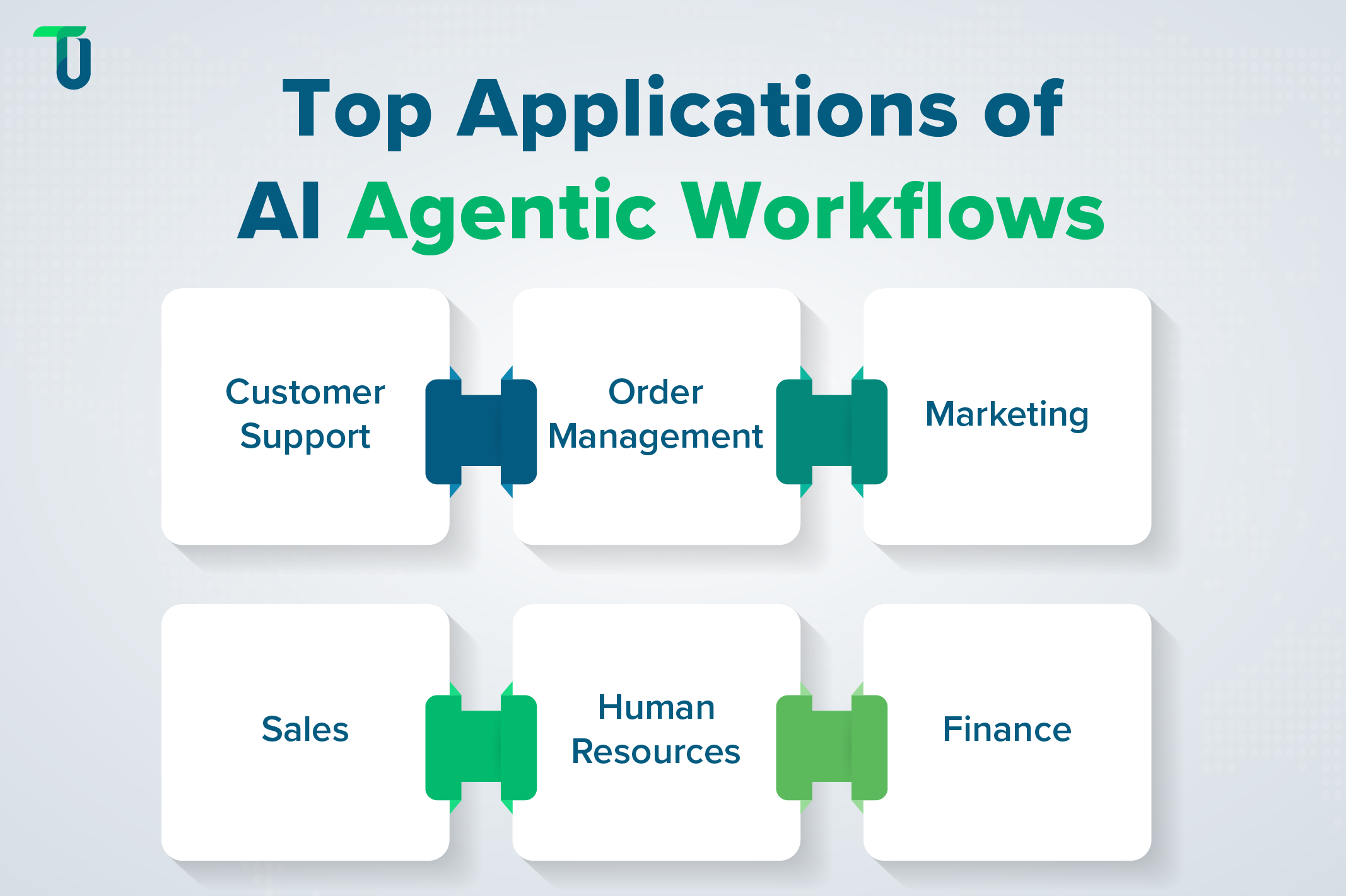
Customer Support: We’ve already discussed, with the example above, how agentic workflows can automate complex, personalized customer interactions. With AI chatbots utilizing agentic workflows and acting as the first point of contact to your customers, your team can focus more on complex queries requiring human intelligence, experience, and empathy. Also, your customers experience reduced response times and always get satisfactory responses.
If you want to learn more about how agentic AI revolutionizes customer experience management, please read our blog.
Order Management: The time between receiving orders and fulfilling them directly impacts your turnover and, eventually, your revenues, profitability, and customer satisfaction. Traditionally, operation teams use multiple automated tools like CMS platforms and ERP systems. But managing siloed data and manually tracking every detail slows down the process.
With AI agentic workflows, the process of reading incoming orders, extracting relevant information, and creating entries in ERP, as well as tickets in the CMS platform, can be automated. This speeds up the process, reduces manual errors, and allows your dispatch team (for products) or delivery team (for services) to act faster.
Want to see this in action? Check out our case study to learn how we build a multi-agent system to automate order management for a manufacturing industry client.
Marketing: Your marketing team spends a lot of time and effort on tasks like content creation, campaign management, performance monitoring, etc. While traditional automation tools help, the workflow remains largely manual.
Using agentic architecture, you can build an AI system to automate your marketing operations at scale. With agentic workflow, an AI agent can be tasked with creating content for emailers, another AI agent can interact with tools to send those emails automatically, a third AI agent can analyze engagement data in real time and recommend adjustments, like optimizing content or changing budgets, and so on.
Sales: Even though your sales team must focus on closing deals, most of their time is spent doing administrative tasks like scoring leads, sending follow-up emails, and analyzing interactions to understand when to reach out. Your sales team can directly focus on engaging prospects by tasking AI agents to complete these activities.
So, an agentic workflow can be designed to allow an AI agent to access the potential of contacts and qualify them as leads, and another AI agent can inform the sales rep to take action while updating the CRM. Another workflow to nurture cold leads can task an AI agent to deliver personalized content and keep them interested till they are ready to convert.
Human Resources: Traditional AI automated individual tasks like scanning resumes, ranking candidates, and scheduling interviews for recruitment. AI agent workflows help build advanced systems that handle the complete flow automatically.
Further, agentic AI can help streamline the automated flow of other HR tasks, like managing documents, updating internal systems, and fetching data-driven insights during appraisals, exits, etc. So, your HR professionals can save time on administrative tasks and focus on strategic activities.
Also Read: Chatbot Using Vision AI and Gen AI for Candidate Search
Finance: Your finance department is busy churning numbers while handling documentation to ensure compliance. Several processes, like expense management, are manual and time-consuming, and agentic workflows can help automate them.
Think of an AI agent workflow for expense management, where an AI agent extracts data from invoices and inputs it into accounting systems, another AI agent makes payments, a third AI agent flags exceptions or deviations in transactions for review, and a fourth AI agent analyses expense data and provides insights for budgeting.
To sum up, the applications of AI agentic workflows can be seen across industries, be it the healthcare, finance, e-commerce, or logistics sectors. With a correct AI strategy, you can identify the areas where agentic workflows can help and build custom AI solutions.
How to Implement AI Agentic Workflows In Your Enterprise
As with any technical implementation, your approach to building AI agentic workflows must be structured and streamlined. Your AI development plans must be feasible and result-oriented. Considering AI consulting before starting your project could be a wise decision. Based on our experience building custom AI solutions, we’ve compiled these steps on how to implement agentic workflows:
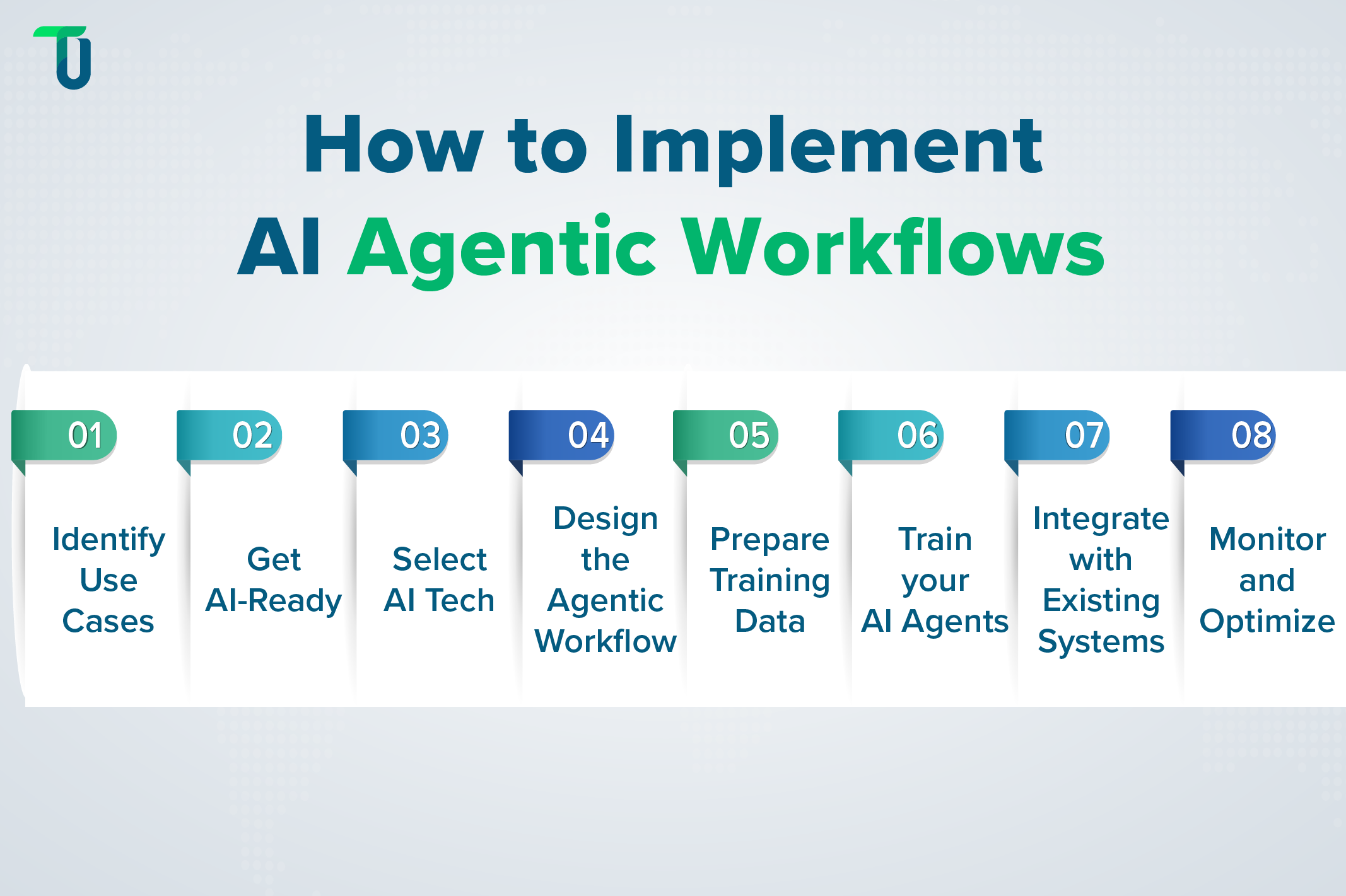
Identify Use Cases: Check for activities requiring decision-making or involving heavy data handling, where automation using agentic workflows could bring good ROI. Traditional AI would be good enough for simple, repetitive tasks.
Related Read: AI Chatbot vs AI Agent: Which Is Right For You
Get AI-Ready: Access the current infrastructure and ensure that it is capable of integrating AI tools, frameworks, and workflows. If not, make provisions for upgrades in your AI development plan.
Also, ensure that the management and employees are ready for the shift by showing them the benefits and involving them in the digital transformation process.
Select AI Tech: Key techniques behind agentic workflows include AI (Machine Learning and Natural Language Processing), AI Agents, Data Analytics, Workflow Orchestration, and Integrations.
Besides, you must pick the right tools. Popular agentic frameworks that help build agentic flows include LangChain, CrewAI, Microsoft AutoGen and Semantic Kernel, etc. Before selecting AI tools, check their integration capabilities, ease of use, etc. Get demos of each, if possible. Further, consider factors like your workflow needs and computing power requirements.
Related Read: Why Renting GPUs Is Better for Your AI Development Project
Design the Agentic Workflow: Define the tasks each agent within the agentic system must handle. Clarify their specific roles and responsibilities. Establish triggers and rules to guide each agent on when and how actions must be taken. For instance, when and how they must seek human involvement for reviews, approvals, etc., or simply, when they must pass on an issue to a human executive.
Establish the hierarchy, reporting, and communication flow among agents. Determine feedback mechanisms to allow the system to learn from its experiences and improve performance over time.
Prepare Training Data: AI agents need data for training, and so, you need to select and prepare the right data sets to train them. Using data engineering techniques, clean and structure the data so that AI agents can consume it. Take care to avoid bias in data at this stage.
Also, implement ethical AI practices while ensuring data governance, security, and compliance. This is very important when you’re handling sensitive and confidential information.
Train Your AI Agents: As AI agents must work with your proprietary data and handle domain-specific, niche tasks as designed for your specific workflows, train them accurately using historical data. Use the right training techniques, including supervised and unsupervised learning techniques, so your AI agents thoroughly learn patterns and understand nuances to make better decisions and provide accurate outcomes.
Also Read: A Comparison of AI Model Training Techniques
Integrate with Existing Systems: Your AI development efforts must enhance and not disrupt your existing operations. So, ensure the AI agentic workflows you develop integrate seamlessly with your existing systems. Plan for effortless integrations with the right tools and techniques.
Monitor and Optimize: You want the AI agents to learn from their experiences and evolve, so continuous monitoring of your AI agent system’s performance post-deployment is non-negotiable. It helps avoid potential risks like biases and issues like hallucinations, and facilitates better optimization for AI success.
Set appropriate evaluation metrics to analyze the health of your AI system’s every aspect, from algorithms and data to workflows and results. This also helps in adapting your AI system to changes in your business conditions and goals. Furthermore, by understanding how your AI system makes decisions and takes actions, you will bring transparency to your AI solution and enhance customer trust.
Also Read: Why You Need LLM Evaluation and Observability
Expert advice: If you’re starting your AI journey or building an AI development strategy, start small. Create and deploy a pilot project to test your strategy. Learn and adapt your strategy as you go on to scale AI adoption across your enterprise.
To Sum Up: Agentic Workflows Are the Future of Intelligent Automation
Automating simple, repetitive tasks is no longer enough for enterprises. They need next-level automation to unlock greater scalability and efficiency in business operations. Agentic workflows make this possible by enabling AI agents to decide and act autonomously. Agentic architectures using single or multiple agents help tailor AI solutions to your enterprises’ needs and align them to your business goals. If applied creatively, agentic AI can find endless use cases and not just the ones we mentioned above. All you need is a reliable custom AI development partner.
At TenUp, we solve our clients’ problems by building custom AI solutions tailored to meet their current and future requirements while ensuring seamless AI integration with their existing infrastructure. Leveraging our experience building many AI-based solutions across industries, we help our clients navigate the complex landscape of AI adoption so they avoid common pitfalls.
Need intelligent automation? The future is agentic. From strategy to execution, our experience building agentic AI-based solutions can help you achieve automation success!
Ready to Automate Smarter?
Explore agentic workflows with TenUp. Let’s drive intelligent automation together. Schedule a free call today!
Frequently asked questions
What distinguishes agentic workflows from traditional automation tools like RPA?
Agentic workflows use AI-powered agents that can learn, adapt, and make real-time decisions based on context—handling both structured and unstructured data. Unlike RPA, which follows rigid rules for repetitive tasks, agentic systems offer dynamic, autonomous automation for complex processes.
How do agentic workflows handle unexpected scenarios or anomalies?
Agentic workflows use AI to monitor and analyze processes in real-time, detecting anomalies and making adaptive decisions. For complex issues, they can trigger human intervention. The system learns from each scenario, improving its ability to handle similar situations autonomously in the future.
What are the key components required to build an agentic workflow?
An agentic workflow combines autonomous agents, data pipelines, memory management, feedback mechanisms, and system integrations to create intelligent and adaptive processes. These components work in harmony to automate tasks and enable workflows that evolve and improve over time.
Can agentic workflows be integrated with existing legacy systems?
Yes, agentic workflows can be integrated with legacy systems using APIs, middleware, or custom connectors. This allows organizations to modernize their operations with AI-driven automation while minimizing disruption and costs.
Which industries are best suited for implementing agentic workflows?
Industries with complex, repetitive, or data-heavy processes—like healthcare, finance, logistics, e-commerce, and customer service—see major benefits from agentic workflows. These workflows can automate decisions, optimize resource usage, and boost operational efficiency.
Examples: Customer Service Automation, Human Resources (HR) Automation, IT Operations and Incident Management & Financial Processes.
How do agentic workflows ensure data privacy and security?
Agentic workflows often incorporate end-to-end encryption, secure APIs, identity-based access controls, and compliance with standards like GDPR or HIPAA. These measures ensure sensitive data is protected while enabling intelligent automation.
What is the role of human oversight in agentic workflows?
Human oversight is crucial, especially in high-stakes scenarios. It ensures agents make decisions aligned with business goals, legal requirements, and ethical considerations. Humans can intervene, audit, or guide the agents when needed.
How do agentic workflows contribute to continuous improvement in processes?
Agentic systems learn from feedback loops and past interactions to optimize future decisions. Over time, they refine their actions, adapt to new variables, and improve performance without requiring constant reprogramming.
What challenges might organizations face when implementing agentic workflows?
Some common challenges include data quality issues, lack of in-house expertise, integration hurdles with existing systems, and resistance to change. Successful implementation requires strong planning, stakeholder buy-in, and possibly a phased rollout strategy.
Are there any open-source frameworks available for developing agentic workflows?
Yes, open-source tools like LangChain, CrewAI, and AutoGen provide building blocks to design, deploy, and manage intelligent agentic workflows. These platforms are community-supported and are reducing the barrier to entry for teams exploring this new paradigm.

